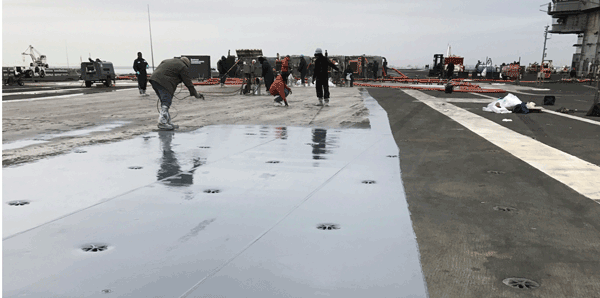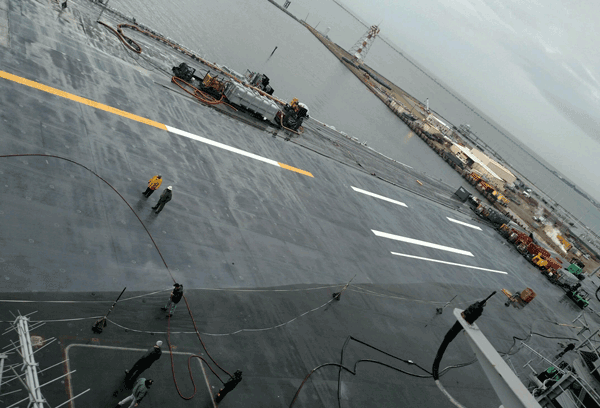Bogey. Boondoggle. CNO. The Navy has a language all its own. But the world of anti-slip coatings, called non-skid in the Navy world, just may rival that — at least when you talk to Surface Technologies Corporation’s vice president, Brian Stump. Bugs, wand, and tarsals are part of his vocabulary.
The process is predictable: prep, prime, non-skid, topcoat, and Visual Landing Aids (VLAs). It’s the specifics of the project that make each coating job unique. On the most recent recoating of the flight deck on the USS Eisenhower, it was the cold weather that distinguished this project.
Permission to Board
Completed in Norfolk, Virginia, the project recoat covered 40,000 square feet (3,716.1 m²) of steel on the supercarrier. Originally the project scope covered 55,000 square feet (5,109.7 m²) but Surface Technologies’ contract was amended once it was determined that not everything needed to be completed before USS Eisenhower’s deployment overseas.
According to Stump, many military top deck projects use containment, but on this project, despite it being completed in the wintertime, they “decided not to do it in an enclosure. That’s why we used cold-cured material.” But that also meant that the crew, which averaged 10 to 12 members, had to work with whatever Mother Nature sent their way.
“Snow, sleet, hail; we had to work within the scope of work to complete the task,” said Stump. Throughout the 28-day project, they were sure to look at the upcoming tasks and the weather and plan accordingly. It was “meticulously planned,” he said.
Another aspect of the contract that was planned down to a T was access. “We’ve been a Department of Defense contractor for 30 years now, and the biggest majority of our guys have been with us for a long time.” By this point, they ought to be used to the process of renewing their security clearance, which occurs every 92 days!
Once security was checked and the bid was won, the crew was able to onboard. All equipment — “vacuums, tanks, pumps, generators, air compressors,” according to Stump — were loaded onto 180- to 200-ton (163.3‒181.4 metric ton) cranes and on to the ship deck. And then they went into “coatings removal mode,” he said.
History Lesson
Using ultra-high pressure (UHP) washers, the crew worked in 10-, 12-, and 14,000-square-foot (929.0 m²; 1,114.8 m²; and 1,300.6 m²) sections at a time. The goal was to avoid losing the blast, so they only worked in sections that they could prime in the same day. “You’re not going to prep and not paint,” Stump said.
There were six UHP pumps up to 40,000 psi (275.8 MPa) that the crew used to remove up to 99 percent of the previous non-skid system. The pumps were manufactured by Hammelmann, Jet Edge, and Jetstream. That was completed per NACE Waterjet (WJ) 2/Society for Protective Coatings (SSPC) Surface Preparation (SP) WJ-2: Waterjet Cleaning of Metals — Very Thorough Cleaning, commonly referred to as WJ-2. This surface profile was specifically prepared to WJ-2L (light). Because they’re just “running the bugs,” they didn’t need to wear any additional safety gear; they wore what they’d wear for steel shot blasting, such as steel-toed boots, according to Stump. “We don’t ‘open wand,’ so you don’t need tarsal or metatarsal covers,” he continued.

As for the equipment itself, Stump said, “We take diesels that we purchased many years ago and put different fluid sections on them, so they’re kind of our own design. Some came out of the oil fields in Texas, and we revamped them to use on this aircraft carrier.” There’s no history lost on this seasoned crew — even for the equipment.
“The same day you UHP waterjet, you meet the standard WJ-2L, then the government comes in, and does a checkpoint to see that you met that standard in accordance with that standard,” Stump explained. “And then you paint.”
Because they exposed the steel surface, they had to ensure that days they prepped and primed, the temperatures were between 35 and 90° F (1.7‒32.2° C). Using two Graco 74:1 pumps, the crew spray applied the high-build epoxy primer. Called MS-11CZ, the cold-cured primer from American Safety Technologies was applied at 3‒6 mils (76.2‒152.4 microns), and the guys spraying were sure to wear safety glasses.
Welcome to My House
Throughout the project, the crew had their own crew member focused on Quality Assurance (QA), and they were double- and triple-checked by a third-party inspector working with the commander of U.S. Navy Naval Air Systems Command (NAVAIR) air force as well as the government’s own inspector. “Could be six or seven people out there looking at this one little area,” Stump said of the hold-point inspection process. “We’ve had government check points last up to two hours, but now it’s down to 30 minutes. We do a lot of the work and you pretty much know when you’re looking at it if it’s satisfactory or not,” he continued. “You kinda know what it’s supposed to look like.”
After the checkpoint on the primer, confirming dry film thickness, the crew moved onto the non-skid coating. This layer, though, couldn’t be confirmed through thicknesses. “You do it through coverage per square foot per gallon,” Stump explained. After mixing (wearing nitrile gloves), the crew applied the American Safety 8000L non-skid coating with 9-inch (22.9 cm) phenolic rollers. It was applied to cover between 18 and 30 square feet per gallon (0.4‒0.7 m²/L). To do that, they’d take the square footage and divide it by the number of cans they had to get the range of coverage rate.
At this point, the crew also beefed up. Stump brought in an additional 8 to 10 crew members to get the non-skid down. “Some evolutions I’d have five mixers going just to mix five cans at a time,” he explained. “It takes a while.”
The final coat, a topcoat by Randolph Products called Color Topping, was applied to any non-skid areas between 4 and 8 mils (101.6‒203.2 microns). “That’s all rolled and brushed,” Stump said. “I have a 1/2-inch [1.3 cm] nap roller just like you use in your house.” For the sailors aboard the USS Eisenhower, this was their house!
Coming Home
In addition to two holidays during the project schedule (Christmas and New Year’s Eve), the crew also had to contend with a few snow days. The coatings are cold-weather cured, but below freezing wouldn’t cut it!
When the weather was acceptable, the coatings crew was able to hit the last item on the punch list: the VLA markings. Applied in yellow, red, green, and white with the same Randolph topcoat, those were created to ensure that the deck would be “aviation certifiable,” Stump said. “They have to be certified by NAVAIR to resume flight operations after we get done — has to be certified to launch and recover aircraft ’cause every one of those lines up there means something,” he continued.
It took the crew three days total to complete the VLA markings, but then they were able to close up and ship out!
